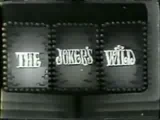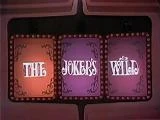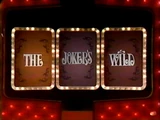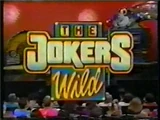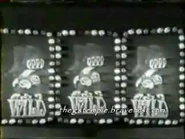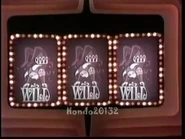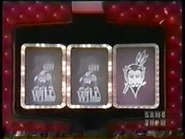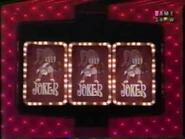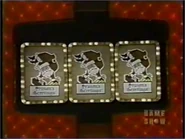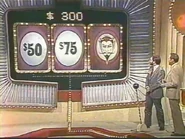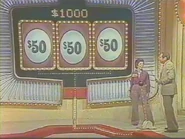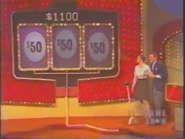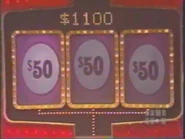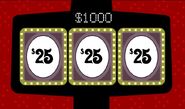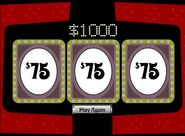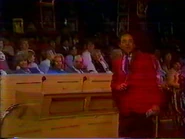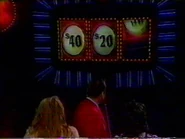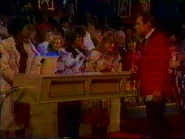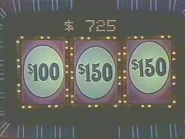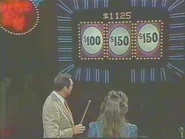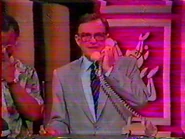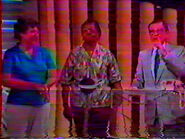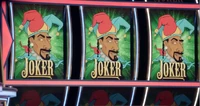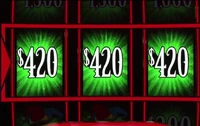| Hosts | |
|
Allen Ludden (1968–1969) | |
| Announcers | |
|
Lee Vines (1968–1969) | |
| Broadcast | |
| Unsold Pilots for CBS: 12/8/1968, 1/5/1969KTLA: 1971 CBS Daytime: 9/4/1972 – 6/13/1975Syndication (Daily): 9/12/1977 – 5/23/1986Syndication (Daily): 9/10/1990 – 3/8/1991 Unsold Pilot for Syndication: 2006 TBS: 10/24/2017 – Present | |
| Packagers | |
| Jack Barry Productions (1968–1975) Barry & Enright Productions (1977–1986) Kline & Friends/Jack Barry Productions (1990–1991) Sony Pictures Television (2006–Present) Snoopadelic Films (2017–Present) SMAC Productions (2017–Present) Studio T (2017–Present) | |
| Distributors | |
| Colbert Television Sales (1977–1986) Orbis Communications (1990–1991) | |
The Joker's Wild is a quiz based game show where categories were presented by spinning a slot machine.
Several categories were in the mix and after choosing a category, you had to answer a question related to it to get money.
One category showing was worth single amount, two of the same category was worth double the amount and three of the same was worth four times. Also, there was one Joker space on each reel, the player had the choice of making the joker any category or by selecting one of the others and the joker.
The show went through three versions.
In 2017, the show was rebooted on TBS after being off the air for more than 26 years, hosted by rapper Snoop Dogg under the "appropriately" self-titled Snoop Dogg Presents The Joker's Wild as it plays slightly different from the original version. However, most of the elements are still there.
1968 Pilot
In this pilot shot on December 8, 1968 and hosted by Password host Allen Ludden, the giant slot machine had categories that "came to life", because the categories were represented by five celebrity guests. They were:
- Irene Ryan - Homemaking
- Pat Paulsen - Politics
- Don Drysdale - Baseball
- Rosemary Clooney - Music
- Rich Little - Show Biz
Two contestants faced the panel of five celebrities and the slot machine with their faces representing the five categories on its wheels, and jokers. What made this version of The Joker's Wild different is that contestants didn't have to answer just one question, they could also answer two or three. They each took turns pulling the lever in front of them to activate the celebrity wheels. When they stopped, the contestant in control could choose which celebrity/celebrities to take. Whichever star was chosen, the panelist would then ask a question or questions under his/her own category in which correct answers scored points according to how many of any celebrity appeared.
One of each celebrity made each question worth one point; two of one celebrity, and one of another made the value of each question be two points; and finally, three of a single celebrity made each question worth three points. Should the contestant in control miss a question, the opponent had a chance to answer a bonus question from the last celebrity to read a question. There were also jokers on the wheels, and like the show says, "The Joker's Wild"; the contestant in control could make the joker(s) into any category/celebrity they liked whether it was on the board or not.
Both contestants took an equal number of turns and the first one to score 13 points won the game. Should the first contestant make it 13 or more first, the other contestant had one last spin in an attempt to catch-up. Finally, if at any time three jokers appeared (that's Joker, Joker, JOKER!), that contestant had a chance to pull off an instant win by answering one question from one category correctly.
The winner of each game won $250 and a chance to spin for three prizes of various qualities, ranging from a 5¢ piece of chewing gum to $500 cash. The winning contestant took up to three spins of the wheels, on each spin, three prizes were displayed. After the first spin, the winner could either keep the first set of three, or reject them all for another spin. On the second set of three the winning contestant could either keep the those prizes, or reject them all for one final spin, and whatever the champ got on the final spin was his/hers to keep.
There were no returning champions in this pilot. Two new contestants every game. Also, losing contestants received a $100 bond.
1969 Pilot
A second pilot was taped a month later on January 5, 1969. There were no celebrities this time, with Ludden simply reading the questions himself; despite this change, the 1968 host-contestant podium remained in use.
Both pilots were produced by Barry in association with CBS, with Lee Vines announcing.
1970 (The Honeymoon Game)
- Main article: The Honeymoon Game
This was a different version of The Joker's Wild; for it was played with celebrities and recently married couples, and was supposedly a 1 1/2 hour show, but instead it became an hour long show.
1971 KTLA Series
A "tryout series" aired locally on Los Angeles' KTLA for about three months and was hosted by Jack Barry. The rules were similar to the rules below with the following exceptions:
- Three contestants competed in each game, with the champion spinning first to begin the game.
- Spinning three different categories and answering a question in any of the three categories was worth $25, while pairs were worth $50 and triples were worth $100.
- $250 was needed to win, and as before an equal amount of turns was given. A three-Joker spin resulted in an automatic win with a correct response to a question from any of the five categories in play.
In the event of a tie, the lowest scorer was eliminated and play continued until one was ahead after each round. The bonus round was similar to that of the Ludden pilots but had more elaborate prizes.
Highlights of this version were shown during promos of the eventual series, which began production on CBS in 1972.
1972-1986 Version
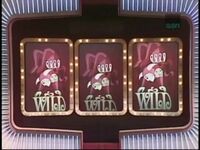
Three Jokers from 1984
In this more familiar version, two contestants faced a giant slot machine and answered questions. On those wheels were five categories. Each contestant in turn pulled a lever in front of them which caused the category wheels to spin. When the wheels stopped, that player was given a choice of up to three categories. Host Barry asked a question under that category and a correct answer won money for that player; but an incorrect answer gave the opponent a chance to steal the money by answering the same question.
Question values were determined by how many of that category appeared. A single category was worth $50, a double category/pair was worth $100, and a triple was worth $200 (originally $150). The first player to reach $500 or more in that player's proper turn won the game.
Also on the wheels were jokers, they're wild (hence the name of the show). The contestants could match up the joker with any category they chose, and they could also use the joker(s) to go off the board, and select a different category. But if at any time three jokers came up (that's Joker, Joker, JOKER!), that contestant could instantly win the game by answering one question from one category correctly; however, if unsuccessful, the opponent could not steal and the game continued as normal. Originally the contestant would automatically win without answering a question by getting three jokers.
Both contestants took an equal number of turns; in the event the first contestant (originally the champion, later the challenger) reached $500 first, the second contestant took one final spin in an attempt to catch-up. In the event of a tie at $500, extra rounds were played and whoever was ahead in score at the end of a complete round was the winner.
The winner of the game kept his/her money and earned a chance to play the bonus game.
Special categories
Special categories were presented during the syndicated era.
- Multiple Choice – Introduced in 1978, a contestant is given three possible answers to a general knowledge question, and had to choose the correct answer.
- Near the end of the CBS run and for the first half of the new syndicated version's 1977-78 season, all questions were multiple-choice, except for some visual categories.
- Pot Luck – A question in which could be almost anything; usually from one of the other categories.
- Grab Bag – A straight-forward general knowledge question.
- Who, What, or Where? – self explanatory
- A to Z/Alphabet Soup – In this category, the host announced a letter which the correct answer began with, then he read the question, and all the contestant had to do was to give the correct answer beginning with that letter (ala Blockbusters).
- This particular category was also used on sister shows Tic Tac Dough & Bullseye. On Tic Tac it was called Take a Letter, and on Bullseye it was called It's the Letter ___!.
- Crossword Definitions – The host would announce the number of letters in a word and read a definition pertaining to that word. The contestant had to guess the word associated with that definition.
- What's Missin_? – A sentence pertaining to a phrase, a title, or a list, was read and the contestant's job was to fill in the missing word or complete the list.
- Today's Name Is... – Questions in this category pertain to a famous person, actor/actress, etc.
- Fact or Foto – Replaced Choose the Clues during the 1985-1986 season. The host gave the subject to the answer, then the contestant had to choose to hear a fact about the answer to a question or to see a photo of the answer. An incorrect response gave their opponent both the fact and photo before answering.
- How Low Will You Go? – Replaced Mystery during the 1985-86 season. This was played similar to Bid A Note on Name That Tune. A question with a list of eight clues was asked and the players bid-off as to how few clues (s)he would need to answer it. A wrong answer meant the opponent was supplied with all the clues before giving an answer.
- Just One More – Identical to Auction on Tic Tac Dough. Given a question with multiple answers, the contestants bid back and forth as to how many they could name. The high bidder won control; if he/she gave an incorrect answer, the opponent could steal the money with one correct response.
- Take a Chance – After hearing the question, the contestant could either answer it him/herself or pass it to the opponent. An incorrect answer awarded the money to the contestant who did not receive the question.
Special Scoring Questions
These categories affected the scoring of the game.
- Mystery(?) – Identical to the Secret Category on Tic Tac Dough, this category debuted on the January 30, 1975 episode of the CBS series, and lasted until after the 8th season of the syndicated run. If and when a contestant spun and picked the category, the question was played for double value. These were seven vertical cards marked with question marks (?) on the front of the host's podium numbered from 1 to 7, representing seven mystery categories. The contestant chose one of those cards, then the host would announce the category (not one of the other 4) and read the question, with a correct answer earning the contestant $100, $200, or $400 depending on the spin. On occasion, the Mystery Category questions could be multiple-choice.
- Fast Forward ____________ – This category debuted on the May 16, 1975 show of the CBS run, was the only special category that lasted throughout the entire syndicated series, and all the questions in that game came from one subject. This was where the contestant could answer as many questions as he/she wished, with the option to stop after each correct answer. Stopping was important, because if at any time the contestant in control gave a wrong answer, he/she lost all the accumulated money won back to the starting score and gave the opponent a chance to answer the missed question for the face value ($50, $100, or $200). This was usually an alternative to three jokers, when someone really far behind needed to catch up.
- Stumpers – Introduced in the Fall of 1983, "stumpers" were all questions missed by both contestants from previous shows. The contestant who spun and chose the category could elect to answer the question for single value after the host gave the two wrong answers given by those two contestants or go for double the dollar value by answering the question without any help. Originally, the category was a straightforward question from any category, with $100 added to the value of the question, making the question worth $150, $200, or $300.
- Bid __________ – A contestant had to answer a certain amount of questions (similar to the format used in the show "Bullseye") to win the money times the number of questions required. To start, the contestant chose how many questions they would like to answer (with a minimum bid of two), with the value of the spin multiplied by the amount of the bid. Should the first contestant miss the question, his/her opponent can complete the bid themselves by answering the remaining questions correctly. An incorrect answer by the opponent ended the questioning and that contestant would spin on their proper turn for another category. Like "Fast Forward", the category could be used to catch up if trailing; unlike "Fast Forward", however, the accumulated money was not lost if the question was missed, allowing the opponent to steal the accumulated money by providing the last correct answer.
- Choose the Clues – The host would reveal the subject for the question and the opponent would decide if the player in control would be given one or two clues. One clue was worth double the amount while two clues was worth the regular amount. If the spinning player was given only one clue and missed, the opponent was given both clues for the regular amount and the chance to answer.
Natural Triple
By May 1974 on the CBS series, and continuing into the syndicated version of the show, contestants won a bonus for spinning a natural triple in the main game in addition to answering a question worth $200. In the CBS series, and from 1977 to 1983 in the syndicated show, contestants who spun a natural triple won a special prize which was kept win or lose. Beginning in the fall of 1983, contestant who spun a natural triple won a special jackpot called the "Natural Triple Jackpot" which was an accumulating jackpot prize package. Prizes were kept regardless of the game's outcome.
Bonus Game
The bonus game had three different versions.
The Prize Wheels
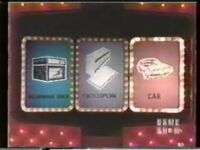
The first ever car win via this bonus game in 1972.
In the first two weeks of the series, the categories were replaced with prizes ranging in value from tens of dollars to hundreds of dollars. The winning contestant spun the wheels up to two times, on each spin, three prizes were displayed. After the first spin, the winner could either keep the first set of three prizes, or trade them back for one more spin, and whatever the winner got on the second spin was theirs to keep.
In the first two shows, some of the prizes were circled. If the winning contestant could spin three circled prizes, he/she also won a car. It was later scrapped in favor of having the car or another big prize on the wheels (usually the third).
The Prize Wheels were briefly revived during the kids' tournament in the syndicated version though it was played differently. The winning kid got to spin the wheels three times. On each spin, he/she picked which prize to take and the wheel with the chosen prize was locked while the other(s) would spin as usual; this would later be the basis for the 1990-1991 version's bonus game.
Jokers & Devils
In this bonus which premiered on the show's third week, the jokers were still on the wheels, but now they were accompanied by devils. The devils were a representation of the late host Jack Barry, and they had a pitchfork behind them. The winning contestant spun the wheels up to three times (originally four). On each spin, if only jokers appeared, he/she won a prize (the prize was generally announced before each spin, but for a brief period, it was announced after a successful spin). But if one devil showed up, he/she lost the prize(s); to prevent this from happening, after each successful spin, the contestant had a choice to stop and take the prizes or continue playing. During the four-spin era, the last spin was worth a new car or another big prize.
Oddly enough, this bonus game and the previous bonus game were played in the same episode that this game debuted. The episode began with the final playing of the Prize Wheels game, and the champion who played that one won the next main game and went on to play the first Jokers & Devils game, which he lost.
During the special weeks where kids played, the kids did not risk any prizes won while going for future prizes.
When this bonus first premiered, the jokers had the word "Wild" underneath them just like the main game. But in 1973, due to the fact that the wheels didn't change in between the bonus game & main game in one episode, the word "Wild" was replaced with the word "Joker".
For Christmas episodes, the Jokers and Devils were replaced with Santa Clauses and Scrooges. Three Santas won a prize, one Scrooge lost everything.
Face the Devil
In this bonus round, which was in place by May 1974, the categories and jokers were replaced by dollar values ranging from $25 to $200, and devils which still resembled host Jack Barry. The winning contestant could take as many spins as they liked. The goal on each spin was to spin only money amounts, each time he/she did that, they would win the combined total of the money amounts shown. But if at any time a devil appeared, the contestant would lose all the accumulated money up to that point. That's why the host gave the contestant the option to stop the game and keep whatever he/she won after each successful spin. But if the contestant could reach $1,000 or more, they not only got to keep the cash, but also won a special prize package; and if they could spin a natural triple (three of the same money amounts), he/she automatically won the money and prizes.
Joker's Jackpot
In the early years of the CBS version, contestants played for an accumulating cash jackpot called the Joker's Jackpot. After each bonus game (before the bonus during a brief period), the champion could decide to either keep the money won in the main game in addition to the prizes won in the bonus game and leave the show, or play another game knowing that if the champion lost that game, the grand total of the main game winnings were lost and added to the jackpot (the bonus game prizes were not in jeopardy). Champions who won three games in a row (originally four), won the Joker's Jackpot. The Joker's Jackpot started at $2,500 and continued growing until it reached $25,000 or more since $25,000 was CBS' winnings limit at the time. Weeks later, after reducing the number of wins to three, breaking the jackpot also won a brand new car. Originally champions who broke the Joker's Jackpot retired from the show; later shows had them continue playing until they lost, stopped or reached the $25,000 limit, with the main game money from previous attempts at the jackpot no longer in jeopardy.
The first contestant to break the jackpot was Kathy Wexler; the jackpot at that time was $13,800, but she never won any prizes because she kept on getting beaten by the devil in the bonus game.
When the Face the Devil bonus game was instituted, the Joker's Jackpot was removed entirely and champions now played for just a brand new car. To win the car contestants had to win five games in a row, and there were no more risks involved, win or lose.
Tournament of Champions
For the first three years of the syndicated version, "Tournaments of Champions" were held annually, featuring eight of the biggest winners from the previous year (for the $50,000 and $1,000,000 tournaments, the tournament field was sixteen). Different rules applied to Tournament of Champions play: the contestants played for points instead of dollars, and in the championship game, two wins out of three were needed for the top prize (three out of five for both the third and fourth tournaments). In the event a natural triple was spun, $500 went to the contestant's favorite charity. Contestants drew numbers to determine who would spin the wheels first. If the contestant who spun first (in the challenger's podium) spun three jokers and answered a question correctly, that player's score would go to 500 points. The one who spun second (in the champion's podium) would get one final turn to tie the game in that case, or win the game if trailing by less than 200 points; so therefore in any case, both players would get an equal number of turns. The player who was ahead after each completed round after the target score of 500 points was reached or exceeded was declared the winner. Also, no bonus game was played throughout the tournament; after one game was completed, another game began.
Frank Dillon won the $50,000 and $100,000 tournaments in 1977 and 1978, respectively; Eileen Jason captured the $250,000 tournament in 1979 defeating Dillon in the finals. The $50,000 was a prize package ($25,000 cash, a trip around the world, and a Chevy Nova), the $100,000 was also a prize package ($50,000 cash, a Buick Skyhawk, several rooms of furniture and 4 seasonal trips [to the South Pacific, Morocco, Switzerland, and Paris]), and the $250,000 prize was a $200,000 cash annuity paid out over a period of ten years plus $50,000 in prizes.
$1,000,000 Tournament
For what would turn out to be the final ToC in 1980 (due to a majority of stations being CBS O&O's who imposed their then-$25,000 limit on winners), The Joker's Wild became the first television program to advertise that it was giving away $1,000,000. It was the total purse for this ToC, whose players would split their earnings with 16 nominated charities. During this tournament, the theme to another Barry & Enright game show, the 1976 version of Break the Bank, was used instead of the regular opening and closing themes; however, the regular Joker's Wild theme was used as a bumper. Also, by the time this tournament came into effect, contestants started to wear nametags, and they would continue to wear them through the end of the series. Cassandra Dooley, one of the participants, had to have her name abbreviated because it was so long.
Money Distribution
| Tourney Rounds | Award |
|---|---|
| Premliminaries | $7,500 for the runner-up & charity ($15,000 total) |
| Quarterfinals | $12,500 for the runner-up & charity ($25,000 total) |
| Semifinals | $20,000 for the runner-up & charity ($40,000 total) |
| Finals | *$250,000 for the winner & charity ($500,000 total). $100,000 for the runner-up & charity ($200,000 total). |
The winner got $25,000 a year for a decade and his/her charity got the full $250,000. The runner-up got $10,000 a year for a decade and the full $100,000 for his/her charity.
Rob Griffin won the $1,000,000 tournament, defeating Cassandra Dooley. Rob donated half his winnings to the March of Dimes, while Cassandra donated half her winnings to Big Brothers Big Sisters.
Audience Game
CBS
During the final season of the CBS run, two different audience games were played. The first simply involved a selected audience member playing the regular endgame; this lasted for four weeks, from 3/3/75 to 3/28/75.
The second lasted from 3/31/75 to 4/25/75, and involved how well the player did in the endgame. Regardless of whether it was won or not, spinning less than $500 gave the audience player three spins, $500-$975 awarded four spins, and winning gave the player five spins. Hitting a Devil on the first spin meant no audience game was played. After this, Jack presented the player with a choice of three envelopes, each containing the name of an audience member. That player and the champ played a variant of the "Jokers and Devils" endgame: spinning three Jokers awarded $100 to each player, and every subsequent Joker-Joker-Joker doubled it for a maximum of $1,600. A Devil took away both players' money, but gave the audience member a consolation prize.
Syndication
From 1981 to 1985, at the end of every show (originally the Friday show), an audience game was played. This was where audience members got a chance to win money for themselves.
Three audience members came on down, and each one took a spin on the money wheels in which its amounts ranged from $10 to $50 plus $100 spaces, for a maximum of $300 in one spin. Originally they could take up to two spins; if they liked what they saw on the first spin, they stayed with it; if not, they could reject the amount and spin again. In either case, whatever they won was theirs, and the audience player with the highest amount of money went on to spin against the devil for more cash and a bonus prize. In case of a tie, a spin-off was played to determine the winner. Any money won from the spin-off spins was added to their totals.
Cullen's Audience Game
In the eighth season when Bill Cullen took over, the rules were modified. Since Bill wasn't able to go to the studio audience due to his limpage from polio crippling him, two audience members came up on stage to play the game. The third player was a home viewer who played the game by phone; he/she had to activate the wheels using the star key (*). Other than that, most of the rules stayed the same.
1990-1991 Version
This version was entirely different from the original. Three contestants competed instead of two, and the questions were all words, phrases, and names, and the contestants' job is to come up with a definition or the meaning of the clue. Correct answers earned money and answered another clue. One mistake caused the opponents to buzz in and steal the money and control by answering the same clue. The game always began with a toss-up question for control of the Joker Machine.
The two survivors of Round 1 moved on to Round 2, and the winner of the game moved on to the bonus game.
The show had two formats during its season-long run, with the show reverting to the first one towards the end of the run.
Format #1

$30... $60... $100!
The Joker Machine (which now better resembled an actual slot machine) had dollar amounts ranging from $5 to $50 on its wheels (in reality video monitors behind windows) with the last reel also containing Jokers. Each spin decided the value of each clue. If the Joker appeared in the third window, the value was tripled (maximum of $300), and the contestant in control had 15 seconds to answer as many clues as he/she could for the tripled value, with an incorrect answer stopping progress.
Round 1
In Round 1 all questions were general knowledge. To start, a jump-in clue was given and the first contestant to buzz in with a correct answer won control of the joker machine and the questions. The first player to reach $500 or more advanced to Round 2 with the second place player, while the third place player was eliminated from the game. The surviving players' scores were also carried over into the next round.
Round 2
In Round 2, dollar values ranged from $10 to $75 (maximum of $450), and the contestant in control had a choice of two categories for which they had to answer clues from. In addition, there was an "Opponent's Choice" space on the third wheel in addition to the Joker, which is just what it sounds like; when landed on, the opponent got to decide the subject. The first player to reach $2,000 or more won the game.
Format #2

A playing of the Categories Format
The rules were changed to have elements of the classic Joker's Wild inserted into the game, but with elements of the definitions format remaining. This time, up on the wheels were categories (ala Classic Joker's Wild), and the Joker could appear in all three windows. Like the title says, the Jokers were wild, and the contestant in control could match it up with any category shown, but there was no right to go off the board as Jokers could only represent categories on the wheels. Also unlike the original, the categories were not announced at the start of a round. As before, values were determined by how many of that category appeared. All amounts were cut in half, meaning that a single was worth $25, a double was worth $50, and a triple was worth $100. Should three Jokers appear in any spin, that contestant automatically had $250 added to his/her score, plus a choice of three categories behind the jokers for $100/clue.
Round 1 was basically the same, except that it now took $1,000 to end it; excluding "Opponent's Choice", the second round was played exactly under the same perimeters.
Bonus Round

Three Jokers from 1991. Good thing about this bonus round is that the Devil has been vanquished.
To start, the winning contestant was given 60 seconds to answer as many words as he/she could. All correct answers began with the same letter given at the start. Host Pat would give a maximum of three definitions, and the player had to give the correct word to the definitions. Each correct answer earned one spin to the joker machine; if he/she didn't know the answer, the contestant could pass.
When time ran out, the contestant took the number of spins earned to the joker machine. On the wheels this time were Jokers, prizes, and cash amounts ranging from $500 to $2,000. There were no Devils in this version. The contestant's job was to match one prize on all three windows in the spins allotted. If the player saw a prize he/she liked, he/she could freeze the window containing that prize, and try to go for that. Jokers were still wild, and the contestant could use them to match up with any prize shown. However, Jokers could not be frozen and they had to be converted to prizes when shown individually. If the contestant could get three jokers in a single spin, that player would win the Joker's Jackpot which started at $5,000, and grew by $500 every day it was not won.
2006 Pilot
This pilot restored the 1972-1986 format, with all values multiplied by ten, first to $5,000 winning. In the bonus round, the values were also multiplied by ten. If the player reached $10,000, they had a decision; keep the money or risk it by playing on. In this instance, a second Devil was added, along with three car symbols. Getting them won a luxury car.
Snoop Dogg Presents The Joker's Wild 2017 Remake
In 2017, TBS announced a new version of The Joker's Wild as Snoop Dogg Presents The Joker's Wild, with Snoop Dogg as host & executive producer along with Jeannie Mai as the co-host, aka "Lady Luck". Michael Strahan (the current host of The $100,000 Pyramid), also serves as executive producer (and occasional question deliverer) [1].
This version also retained the basic elements of the 1972-1986 format, but replaced straightforward trivia questions with different challenges, usually video clues similar to the original. Some of these video categories would be delivered by celebrities like Strahan (as described above), fellow rapper Wiz Khalifa, fashionista Kelly Osbourne, or celebrity stoner Seth Rogan. More rarely, a category would require the player to roll a single six-sided die to determine how many clues Snoop would give the player.
Unlike the original, the front game has no set goal amount to reach, as this format is self-contained with no returning champions. Each player gets four spins in the Round 1 and three in Round 2 (with the player who is trailing starting Round 2). In Round 1, a three-way split is worth $100 for the chosen category, a Two of a Kind is worth $200, and a Three of a Kind is worth $300. Spinning three Jokers earns a separate general knowledge question for $500. These amounts double for Round 2 ($200 for a single, $400 for Two of a Kind, $600 for Three of a Kind, and $1000 for three Jokers). Also unlike the original, Jokers only match the categories shown on the board for a given spin, so a player can't go "off the board" to choose a different category. (Example: A single category and two Jokers or a Two of a Kind and a Joker is automatically treated as a $300 or $600 Three of a Kind.) The player with the most money after all spins are used wins the game, keeps their money and goes on to the bonus round; the runner-up gets a gift bag from Snoop containing merchandise from his various companies. NOTE: If at any point, one player gets an insurmountable lead (more than $1000 ahead) or the trailing player's final spin would not accumulate enough to tie or overtake the leading player, the leading player automatically wins. Notable here is that Snoop pays the winner of the front game with $100 bills, counting them out one at a time in similar fashion to how Jack Barry would pay off winning players during the Bonus Round.
The bonus round is similar to the original, with values of $300, $420 (according to Snoop, his "favorite number"), $500, $750, $1,000 and $1,500. In addition, as in the 1990 version, there are Jokers. These aren't actually wild; instead, they are worth $2,000. Unlike the original, a natural triple of any cash amount doesn't win automatically. (As seen in the picture here, spinning three "$420"s simply earns $1,260, but not an instant win.) As before, getting a Devil means the money goes up in smoke, so the player can stop after any successful spin and take the accumulated money to that point. But getting three Jokers in one spin or amassing $10,000 or more wins the player $25,000, in addition to the money won in the front game.
Gettin' Wild with Snoop Dogg
- Main article: Gettin' Wild with Snoop Dogg
This was an all-exclusive, six episode only documentary series directed by Rory Karpf where it chronicles Snoop Dogg's transformation into a game show host and explores his creative process behind the show's reboot. This only airs on the TBS app, TBS social media handles including Facebook Watch tab and TBS.com's very own website. Episodes were uploaded each and every Friday at ironically enough 4:20.
Big Winners
Tex Crenshaw – He appeared on the show during the premiere week of the CBS Joker's Wild. Tex was the first contestant to win a car on the show. He won it after defeating two-time winner Mary Sprouse, by playing the second version of the prize round. At that time, the circles were removed in favor of having the car or any other big prize on the wheels. Tex took his two spins, and after rejecting the prizes on his first spin, he took his final spin which gave him the car. Upon winning the car, he came up to the board pointed at the car, and hugged and shook hands with host Jack Barry.
Kathy Wexler – She was the first contestant during the CBS run to win the Joker's Jackpot. By that time the rules were changed so that the Jackpot could be won by winning three games instead of four. Supposedly, she would have won it by having the challenger lose on the final turn, but she actually won it by stealing the question on Entomology (insects). The challenger missed by saying "locust" & "grasshopper" (though game show rules state that a contestant's first answer must be accepted), causing Kathy to strike pay dirt with her saying the correct answer "Bollweevil". The jackpot at that time was $13,800, which was added to the $1,600 she won from the three games she won giving her a total of $15,400 all in cash (no bonus round prizes).
Ken Phyfe – He was another big winner from the CBS run. He was the first contestant to break the Joker's Jackpot more than once. Prior to the game in which he broke the jackpot the second time, he played a major unusual game against then challenger Karen Vensusan; both players ran into trouble answering questions from two categories (Bing Crosby & Horse Racing). In the end, Karen lost with no money at all while Ken added another $550 to his total. Then in the next game on the next show after playing his bonus game in which he won all three prizes, Ken played against a lady named Ingrid Van der Sapp from Holland in which he won and broke the Joker's Jackpot for the second time with a score of $500-$350. His total for breaking the second jackpot came to $17,267.
Tom Parish
Mark Gluckman
Hal Shear – He mostly won the game and bonus games by the use of his plaid suit aka his "Lucky Suit". At one time, a challenger named Adrienne Carter was on the verge of becoming the new champion because she reached $500 first, while Hal supposedly lost with $200. According to the rules, both players must take the same number of turns; when the first player (originally the champion, later the challenger) reached $500 first, the other player must take one last spin in order to catch up. So after Adrienne reached $500 first, Hal took his final turn; he was trailing by $300 so he only needed three jokers to win the game. So to start, he rubbed his suit, then he pulled the lever, and as luck would have it, he got the three jokers he needed, causing Jack Barry to act like he was drunk and jokingly tell Hal, "Don't you EVER take that suit off, EVER, for the rest of your life!" Following that, Hal managed to answer his question correctly about Radio City Music Hall in the News '78 category, and won his eighth game. This by far was one of the greatest comebacks in game show history.
Eileen Jason
Frank Dillon
Cassandra Dooley
Rob Griffin
Joe Dunn – He was the show's only retired champion in the syndicated run having won $66,200. His retirement from the show came to pass due to the fact that the show (because it was aired in mostly CBS' O & O stations) was following CBS' winnings limit rules which had just increased from $35,000 to $50,000. Before he won $35,000, the producers were already discussing raising the winnings limit, before finally deciding to increase the limit to $50,000. Since his winnings were beyond that limit, $16,200 of his winnings were donated to his favorite charity, and the rest he got to keep.
Thomas Van Dyke – He was the 90s version's biggest winner having appeared 14 days (won 13 of those days), and on his next to last day, he won the Joker's Jackpot of $17,500. His final total was $55,562 in cash & prizes, all won during Format #1, the "Dollar" format.
Mary Hunt – She holds the distinction of winning the largest Joker's Jackpot in the history of the show which was $36,000 plus the $2,000 she won from the game for a total of $38,000 in cash, all won during Format #2, the "Category" format.
Trivia
- Per the words of ex-KCOP employee Lou Schneider, the set and the Joker Machine for the 1977-86 run worked thusly: "The slides were mounted on three flat wheels that spun through modified Kodak Carousel slide projectors with slots cut in them so that the spinning wheel could pass the slides between the light and lens. The wheels themselves were mounted on a frame to the side of each projector and were spun by an electric solenoid when the contestant pulled the handle. At pre-set times another solenoid would extend an arm and catch a matching notch in the wheel to stop the wheel at a slide. There was no sensing of where the wheel was at any moment so the chance of a particular slide coming up was entirely random. Likewise, the machine operator did not spin the wheels by hand or otherwise touch the machine during the course of the game. All the operator did was control the slide machine lamps and the lights around the outside of each window that signified matching categories. There were another two projectors, standard Kodak Carousels, that fed a smaller rear projection screen behind the host's position. These were used to display the categories of questions as Jack read them off at the beginning of each round."
- Schneider also explained the set change in the show's run and taping-related facts: "Five shows (a week's worth) were taped in a single day, with two or three days worth of taping scheduled back to back. Since KCOP only had a single production studio and it was leased to other clients between Joker tapings, the set had to be torn down and placed in storage after each taping session. The original syndication set was the one built by CBS for the network run, slightly modified to fit in the smaller KCOP studio. This was a permanent set which remained set up in a dedicated studio at CBS, so it wasn't designed to be torn down on a regular basis. After a couple of years of being set up and torn down it literally wore out. This is why the set was replaced by the neon blue one, which was designed to be taken in and out of storage more easily. Contestant security was very tight during the tapings. Station personnel were not allowed to approach any contestant, and they were isolated in a backstage area during the tapings. Even bathroom breaks were supervised, with B&E employees insuring the rooms were empty before contestants were allowed to use the facilities. The sound effects came from two different sources. There was an auxiliary audio console set up in the back of the audience riser where an audio engineer controlled the audience PA feed. Since he had an unobstructed view of the stage, he also fired the machine's audio sound effects from a bank of 6 cartridge machines. The live audience was miked to pick up their reactions, but this was supplemented by a second operator in the audio control room. He controlled a McKenzie multiple playback tape machine that contained about two dozen 5-10 second snippets of various audience reactions. These supplemented the live microphones to sweeten the audience reactions. This machine also played all of the theme music, bumpers and sound effects not controlled by the PA operator. All of the audio production was done live during the taping, and the shows emerged from the studio essentially ready to air. All that needed to be added in post production were the prize announcements and commercials."
- The 1990-1991 Joker Machine, meanwhile, ran on a video-based system (as evidenced by the video windows in lieu of slide projectors) and actually resembled a slot machine with the handle on the side to be used during the bonus round. This Machine also had a dedication plaque commemorating Jack Barry mounted to it, beneath the middle window.
- The pilot for the 1990-1991 run, taped in September 1989, had a few noted differences from the series, including the absence of the Joker character from the top of the Joker Machine (instead, the show's logo against a swirling orange circle was atop the Machine) and from the graphics on the wheels (though a different depiction of the Joker was seen on Pat Finn's question card holder); additionally, the third reel appeared to hold time amounts instead of cash; presumably this was to determine how much time a contestant would have to answer definitions.
Possible Reboots
- Two attempts have been made to revive The Joker's Wild. The first try was made in 2006 and was paired with a show called Combination Lock but with no success; the first pilot was hosted by game show veteran Mark Maxwell-Smith (of The Cross-Wits, Knockout, Talk About, Supermarket Sweep and Masters of the Maze), while the second was hosted by eventual GSN Live host Alex Cambert; Charlie O'Donnell reprised his announcing functions for these pilots as well. The Joker Machine for these pilots was previously used on Wheel of Fortune, as a backdrop for the contestants during the 2005 Vegas Week (with video walls for each tumbler). Per John Ricci (creator of Lock), both shows were pitched to the NBC owned stations, but King World didn't like NBC's offers, red tape interfered, and both projects were shelved.
- A second attempt was made in 2009 when CBS considered a remake of The Joker's Wild with host Tom Bergeron as one of the shows to replace the cancelled soap opera Guiding Light and serve as a companion to either The $1,000,000 Pyramid, Let's Make a Deal or The Dating Game. However, no pilot was shot.
Additional Pages
- The Joker's Wild/Quotes & Catchphrases
- The Joker's Wild/Merchandise
- The Joker's Wild/Gallery
- The Joker's Wild/Categories Gallery
- The Joker's Wild/Video Gallery
Spin-Offs
The Honeymoon Game – A unsold spinoff pilot tried in 1970
Joker Joker Joker – A children's version that ran 1979-1981
The Joker's Wild & Tic Tac Dough Special - A local special that aired on KCOP in 1981.
Gettin' Wild with Snoop Dogg – A six episode documentary series that ran exclusively on TBS app, TBS social media handles including the Facebook Watch app and at TBS.com in 2017
Rating
Music
1969, 1972-1974, 1977-1978 Open - "The Savers" by Gershon Kingsley & Jean Jacques Perrey
1990 - Joe Manolakakis
1972-1975, 1977-1978 Cues
1972-1974 - Ole Georg Music
"Jet Generation" by Sammy Burdson
"Milky Way" by Henrik Nielsen
"Pop Promotion" by Gerhard Narholz & Jurgen Jaenner
"Shopping Centre" by Manfred Minnich
Joker's Jackpot Win - "Mardi Gras" by Henrik Nielsen
Ticket Plug - "Bell Hop" by John Shakespeare
1974-1975 - Alan Thicke
Main - "Joker's Jive"
Commercial (1975) - "Morning Sun"
1975, 1977-1978 - Ole Georg Music
"Indian Boots" by Horst Bredow
"Jet Generation" by Sammy Burdson
"Sunny Beach" by Tony Tape
"Berkenhead School" by Jack Arel & Jean Claude Petit
"Funky Express" by Duncan Lamont
"Punch Drunk" by Duncan Lamont
"Swamp Fever" by John Cameron
Categories Reveal - "Gamineries" by Jean Leroi
1978 - Hal Hidey
Audience Game - "Keep Travelling"
Devil - "Bits And Pieces"
Studios
KCOP Studios
CBS Television City, Hollywood, California (CBS & 90s Syndicated Versions)
Sony Pictures Studios, Culver City, California (Current Version)
References
Links
Information on The Joker's Wild Pilot
THE JOKER'S WILD HOMEPAGE
The Joker's Wild @ Game Show '75
Adam Nedeff's page on the Bill Cullen years of The Joker's Wild
Adam Nedeff's older page on the Bill Cullen years of The Joker's Wild
David's CBS Joker's Wild Page
David's Syndicated Joker's Wild Page
Rules for The Joker's Wild at the Game Show Temple
Josh Rebich's Joker's Wild Rules Page
Flash game of Face the Devil
Older Flash game of Face the Devil
Official Website of the 2017 TBS version
YouTube Videos
Kathy Wexler becomes the first to win the Joker's Jackpot
Carmen Gutierrez becomes the first to win the Joker's Jackpot via three Jokers
Mary Hunt's $36,000 win from the 1990-91 version
